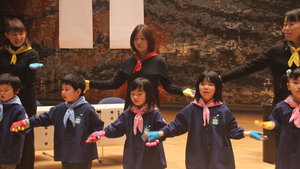Advertisement
Published: March 27th 2012

 Elementary school children...
Elementary school children...
...singing at a one-year memorial ceremony.Between the earthquake in Haiti in 2010 and the Great East Japan Earthquake last year, a lot has been said about the effects of natural disasters on the health and well-being of the communities that are affected the most. Much of the dialogue has revolved around how to rebuild these communities using limited (and sometimes nonexistent) financial and logistical resources from NGOs and foreign governments. While these discussions are immensely valuable, and usually succeeded by an initial outpouring of aid and volunteerism from the international community, they are usually somewhat short-lived. But, unfortunately, it often takes years, if not decades, to rebuild the lives of those who have lost their homes, loved-ones, and livelihoods. This is especially true in the case of Japan, where it is still unclear how long people will continue to feel the financial and health consequences of the radiation spill.
While the initial outpouring of aid is
extremely important (and I do not wish to degrade the efforts of these initial responders!), there appears to me to be a huge gap in the area of long-term support systems for disaster victims. This is perhaps most noticeable in the area of aid for children. In Japan, for
instance, many of the children who live in the coastal regions of Fukushima were witness to unthinkable emotional and psychological trauma, and the little research that has been done in this area has shown that these children are also more prone to disorders such as PTSD (post-traumatic stress disorder) than their adult counterparts. This is especially true when the children have lost a parent and/or have had to be relocated from their homes.
In Fukushima, though, there is an additional problem. In addition to the life-long health concerns that the children face, they will likely also experience some sort of social and/or economic discrimination in other parts of Japan for the rest of their lives (primarily caused by the intense prejudice against radiation victims that started with the nuclear bombings of Hiroshima/Nagasaki in World War II). It is unclear what, if anything, can be done at this point to address this problem, other than educate people outside Fukushima that radiation poisoning is not contagious (something that I was surprised to find is not known in much of Japan).
For now, though, there are some small but extremely worthwhile interventions in Fukushima to help the children continue to develop
'normally' both physically and psychologically. One of the most successful ones consists of a series of indoor playgrounds called "PEP" (I'm not sure what the acronym stands for) that allows kids to just...be kids. Because many parents do not let their children play outside due to the radiation in the soil, this type of intervention is extremely important as it allows children to develop many of the social skills and health habits that will assist them for the rest of their lives. While the intervention is still in its infancy, it will hopefully be a vital first step in helping the children of Fukushima become well-adjusted adults and productive citizens of Japan in the years and decades to come.
Advertisement
Tot: 0.141s; Tpl: 0.01s; cc: 20; qc: 90; dbt: 0.0814s; 1; m:domysql w:travelblog (10.17.0.13); sld: 1;
; mem: 1.2mb

 Elementary school children...
Elementary school children...

auspicious
Michelle Duer
This was very educational. Thanks so much for sharing. :)